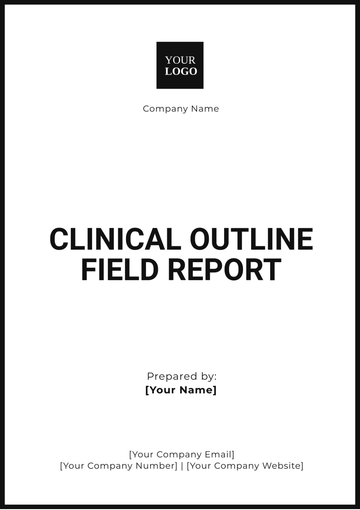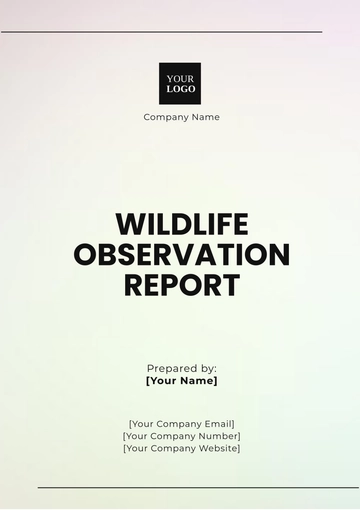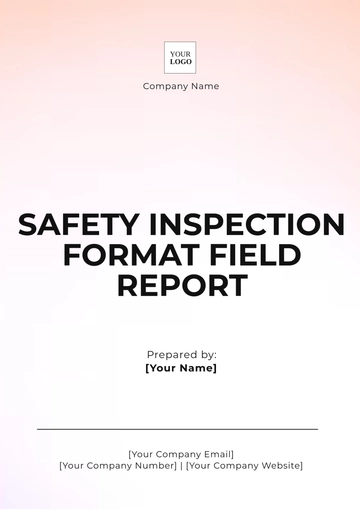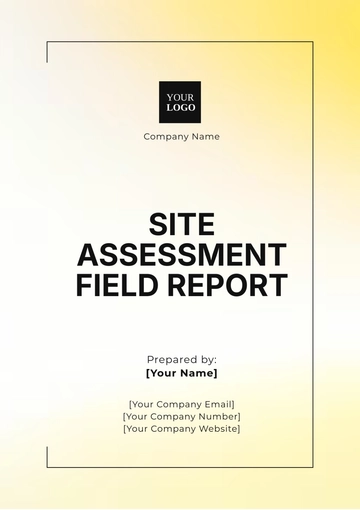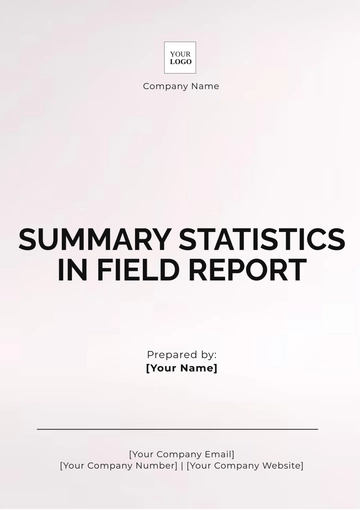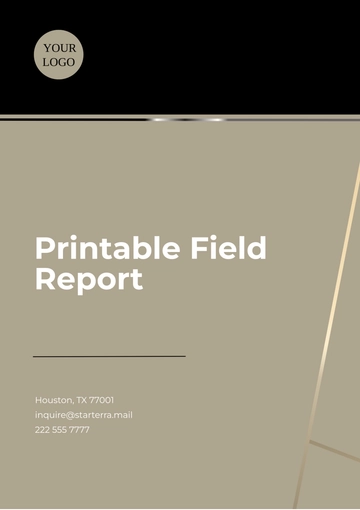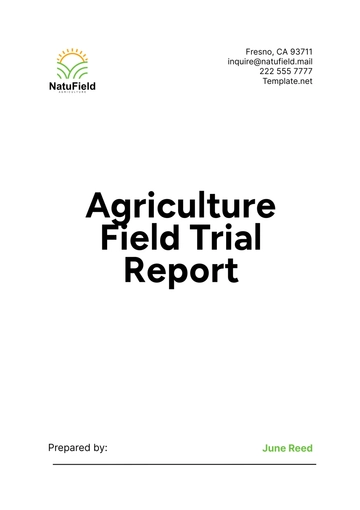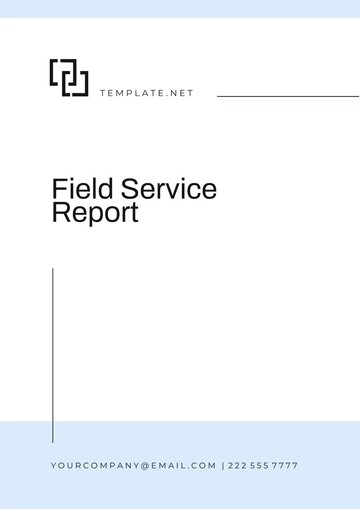Free Sales Marketing Field Report

Prepared by: [Your Company Name]
Date: [Date]
I. Executive Summary
This report provides an in-depth analysis of the recent sales and marketing activities conducted in the field, incorporating key insights from various campaigns, customer interactions, and sales performance metrics across multiple regions. The primary objective of this report is to evaluate the effectiveness of the current strategies and identify areas for improvement. This evaluation includes customer feedback on products and services, the performance of the sales teams, and the impact of evolving market trends, with an emphasis on increasing customer satisfaction and capitalizing on emerging opportunities.
In summary, while the current sales strategy has been effective in meeting targets in most regions, the analysis highlights a growing demand for eco-friendly products and a need for enhanced customer service to boost overall satisfaction.
II. Objectives
II.I Primary Goal
The primary goal of this report is to assess the effectiveness of current sales and marketing strategies by gathering firsthand insights directly from field operations.
II.II Specific Objectives
Gather customer feedback on our products and services to understand their satisfaction levels and areas for improvement.
Identify key market trends affecting consumer behavior and purchasing decisions.
Evaluate the performance of the sales team in engaging customers, addressing their needs, and meeting sales goals.
Assess regional differences in customer preferences and sales outcomes to fine-tune future strategies.
III. Methodology
III.I Data Collection Methods
Data for this report was collected through the following methods:
Customer Interviews: Direct interviews were conducted with both existing and potential customers across five regions to gauge product satisfaction, service quality, and pricing perceptions.
Observation of Sales Interactions: Sales team members were shadowed during their interactions with customers to evaluate their approach, communication skills, and problem-solving capabilities.
Sales Data Analysis: Sales figures, target achievements, and campaign performance metrics were analyzed to identify correlations between customer feedback and sales outcomes.
III.II Sampling
A representative sample was chosen to ensure diversity in feedback:
Customers: 100 customers, segmented by age, income, and purchase history, participated in the interviews.
Sales Team: A group of 20 sales team members was observed across five regions.
Regions: The regions selected for data collection included North, South, East, West, and Central, representing diverse market dynamics and customer demographics.
IV. Findings
IV.I Customer Feedback
Aspect | Feedback | Percentage |
|---|---|---|
Product Satisfaction | High | 85% |
Service Quality | Moderate | 70% |
Pricing | Competitive | 75% |
Eco-Friendliness | Positive Trend | 60% |
After-Sales Support | Needs Improvement | 65% |
Key Insights:
Product Satisfaction: The majority of customers expressed high satisfaction with product quality, specifically mentioning durability and reliability.
Service Quality: While customers were generally satisfied with their initial purchase experience, 30% highlighted long response times and inadequate problem resolution during after-sales support.
Eco-Friendliness: 60% of customers indicated a preference for environmentally sustainable products, with younger demographics (ages 18-35) showing the strongest preference.
IV.II Sales Performance
Region | Sales Target Achieved | Percentage |
|---|---|---|
North | Met | 100% |
South | Exceeded | 115% |
East | Met | 95% |
West | Below Target | 85% |
Central | Exceeded | 110% |
Top-performing Region: Region 3 (South) exceeded its sales target by 15%, largely due to highly effective customer engagement techniques, such as personalized service and proactive problem-solving.
Underperformance in the West: The West region fell below target due to stiff competition and lower customer satisfaction scores related to service quality.
IV.III Market Trends
Eco-Friendly Products: 60% of customers expressed a growing interest in environmentally sustainable products, aligning with broader industry trends towards green consumerism.
Digital Sales Channels: Increasing customer reliance on digital platforms for product research and purchasing decisions was observed, with 40% of sales inquiries initiated online.
Price Sensitivity: In lower-income regions, price competitiveness remains a critical factor, with 75% of customers noting that affordability influences their purchasing decisions.
V. Analysis
V.I SWOT Analysis
Strengths:
Strong product satisfaction (85% customer approval).
Diverse product range appealing to different demographics.
Brand recognition remains strong in key markets.
Weaknesses:
Service quality is perceived as moderate (70% satisfaction), especially regarding after-sales support.
Underperformance in the West region signals a need for localized strategy adjustment.
Opportunities:
The rising demand for eco-friendly products presents a major opportunity for product line expansion.
Strengthening digital sales channels can boost lead generation and customer engagement.
Threats:
Intensifying competition in specific regions, particularly the West, could pose a challenge to maintaining market share.
Customer expectations for faster, more efficient service, especially after-sales, may impact brand loyalty.
V.II Correlation Between Customer Feedback and Sales Performance
The analysis shows a clear correlation between customer satisfaction with service quality and sales performance. For example, regions where service quality was rated highly, such as the South, reported above-target sales performance. Conversely, in regions with lower service satisfaction, such as the West, sales targets were missed, highlighting the importance of service improvement.
VI. Conclusions and Recommendations
VI.I Key Conclusions
Product Success: Overall, the field data indicates a high level of customer satisfaction with the quality and pricing of our products, which is a positive indicator for future growth.
Service Improvement Needed: Moderate satisfaction levels regarding service quality, especially in after-sales support, point to an area where improvement is crucial to maintaining customer loyalty.
Market Trend Shift: The growing preference for eco-friendly products signals a clear opportunity for product diversification and marketing campaigns focused on sustainability.
VI.II Recommendations
Enhance Sales Team Training:
Develop comprehensive training programs aimed at improving customer interaction skills, focusing on active listening, empathy, and efficient problem resolution during after-sales support.
Expand Eco-Friendly Product Line:
Leverage the rising demand for sustainable products by introducing eco-friendly product lines, with a marketing campaign targeted at environmentally conscious consumers.
Improve After-Sales Service:
Invest in a customer support platform that offers faster response times, real-time problem tracking, and personalized follow-ups to boost customer satisfaction.
Localized Strategy for Underperforming Regions:
Revise the sales and marketing approach in underperforming regions (e.g., West) to better align with local market dynamics, potentially by offering more competitive pricing or tailored promotions.
VII. Appendices
VII.I Customer Interview Questions
How satisfied are you with the quality of the products?
Were you happy with the customer service experience?
How competitive do you find the pricing of our products compared to other brands?
Do you prioritize eco-friendly products when making a purchase?
How would you rate the after-sales support you received?
VII.II. Sales Performance Data
Detailed tables showing monthly sales figures, target achievements, and comparisons across different regions, along with graphical representations of key performance metrics.
- 100% Customizable, free editor
- Access 1 Million+ Templates, photo’s & graphics
- Download or share as a template
- Click and replace photos, graphics, text, backgrounds
- Resize, crop, AI write & more
- Access advanced editor
Streamline your marketing insights with the Sales Marketing Field Report Template from Template.net. This editable and customizable template allows you to easily capture key sales data and analyze marketing trends. Use it to create comprehensive reports with real-time insights. Editable in our AI Editor Tool, you can tailor the template to your specific needs, ensuring accuracy and efficiency for all your sales and marketing reporting.
You may also like
- Sales Report
- Daily Report
- Project Report
- Business Report
- Weekly Report
- Incident Report
- Annual Report
- Report Layout
- Report Design
- Progress Report
- Marketing Report
- Company Report
- Monthly Report
- Audit Report
- Status Report
- School Report
- Reports Hr
- Management Report
- Project Status Report
- Handover Report
- Health And Safety Report
- Restaurant Report
- Construction Report
- Research Report
- Evaluation Report
- Investigation Report
- Employee Report
- Advertising Report
- Weekly Status Report
- Project Management Report
- Finance Report
- Service Report
- Technical Report
- Meeting Report
- Quarterly Report
- Inspection Report
- Medical Report
- Test Report
- Summary Report
- Inventory Report
- Valuation Report
- Operations Report
- Payroll Report
- Training Report
- Job Report
- Case Report
- Performance Report
- Board Report
- Internal Audit Report
- Student Report
- Monthly Management Report
- Small Business Report
- Accident Report
- Call Center Report
- Activity Report
- IT and Software Report
- Internship Report
- Visit Report
- Product Report
- Book Report
- Property Report
- Recruitment Report
- University Report
- Event Report
- SEO Report
- Conference Report
- Narrative Report
- Nursing Home Report
- Preschool Report
- Call Report
- Customer Report
- Employee Incident Report
- Accomplishment Report
- Social Media Report
- Work From Home Report
- Security Report
- Damage Report
- Quality Report
- Internal Report
- Nurse Report
- Real Estate Report
- Hotel Report
- Equipment Report
- Credit Report
- Field Report
- Non Profit Report
- Maintenance Report
- News Report
- Survey Report
- Executive Report
- Law Firm Report
- Advertising Agency Report
- Interior Design Report
- Travel Agency Report
- Stock Report
- Salon Report
- Bug Report
- Workplace Report
- Action Report
- Investor Report
- Cleaning Services Report
- Consulting Report
- Freelancer Report
- Site Visit Report
- Trip Report
- Classroom Observation Report
- Vehicle Report
- Final Report
- Software Report






